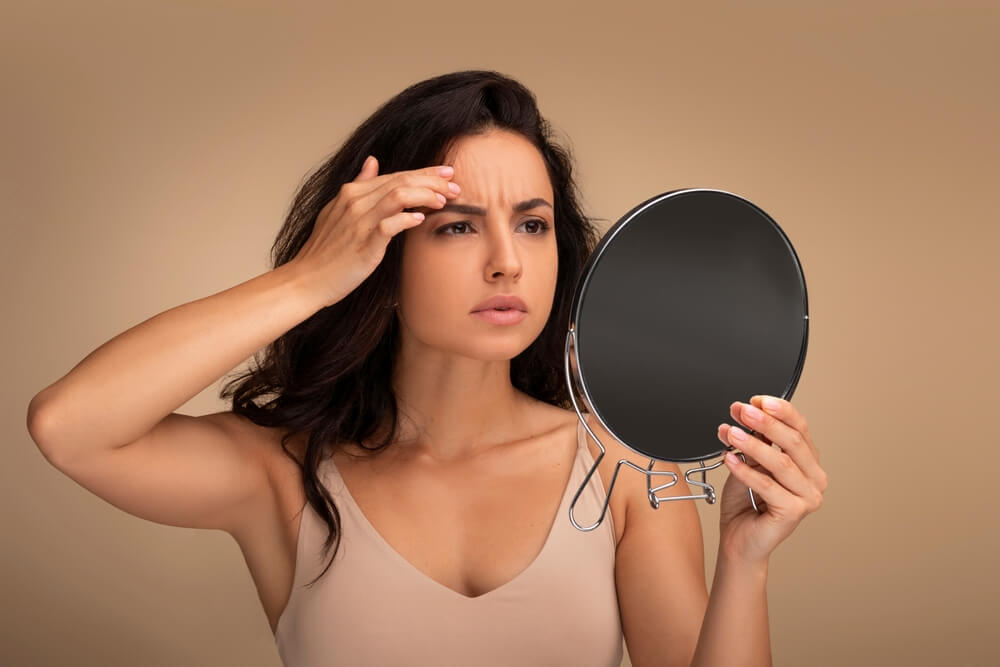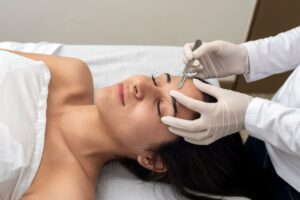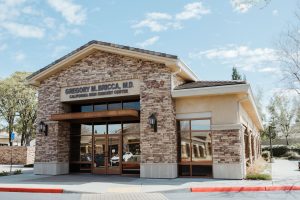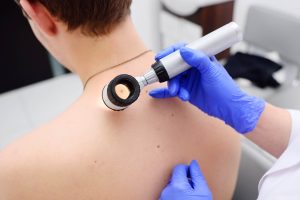A dermatologist caring for patients during the pandemic reveals several COVID-related “Skin-Diseases-of-the-Month”
Dr. Lillian Soohoo, Board-Certified Dermatologist, The Menkes Clinic, Mountain View, CA
It’s been six months since the world came to a halt and those who could, locked themselves in their homes. Along with the new habits we’ve fallen into during COVID, I’ve noticed an interesting trend in the types of skin conditions my patients have been experiencing since March.
These “new” skin problems are mostly the result of unusual behaviors we have come to normalize in response to the pandemic. In particular, changes in levels of physical activity due to home confinement, stress eating, the disruption of normal sleep patterns and an obsession to maintain absolute cleanliness have negatively affected many patients. These are what I refer to as COVID lifestyle changes which, together with self-isolation and emotional stress, have created a novel environment for the emergence of several recognizable skin diseases.
As a busy dermatologist who has been caring for patients throughout this pandemic, I’ve come to realize that there has literally been a “Covid-Related
Skin-Disease-of-the-Month” starting with the lockdown in March.
Below is a monthly timeline of emerging skin-related health problems I have seen since the beginning of Quarantine:
Month 1 (Late March): Itchy, Burning, Scaly “Raw” Hands
Reason:
-Frequent, obsessive hand washing
-Too much exposure to soaps, water, hand sanitizers and the chemical disinfectants used on hard surfaces, computer keyboards and touchscreen devices
-Extremely common due to widespread fear of contracting the COVID-19 virus
Treatment:
-Reduce frequency of hand washing
-When washing, use hand soap only before eating and after using the bathroom
-Stop using hand sanitizer completely
-Switch to a mild, non-drying soap, such as Toleriane Dermocleanser by La
Roche Posay (widely available). Avoid Dove and Method brands since they contain preservatives and fragrances that may cause allergic skin reactions and promote dry skin.
-Apply prescription-strength steroid ointments as directed by a physician if rash persists
Month 2 (Late Mar-Apr): Painful, Itchy, Purple Skin Patches on Toes, Feet and Ankles, “COVID toes”
Reason:
-This unique skin finding known as “COVID toes” proved to be one of the first identifiable COVID-19 symptoms in addition to fever, cough and fatigue.
-Due to small clots in blood vessels.
-Uncommon
-Manifests late during the course of a COVID-19 infection
-Seen mostly in children and teens
-The incidence has sharply declined in my practice region (Silicon Valley/SF) since lockdown. I diagnosed several pediatric patients in March and April, but none since then.
Treatment:
-No specific therapy
-Goes away within a few weeks without scarring
-Obtain COVID testing to confirm infection status
-Apply prescription-strength steroid ointment for itching, if needed
Month 3 (May): Itchy, Burning, Swollen Rashes on the Face
Reason:
-This is what I call the “Amazon Prime Rash.”
-At this point during the pandemic, patients reported worsening feelings of depression and anxiety.
-In an attempt to improve their appearance on Zoom calls and to feel better about themselves, patients began ordering a myriad of cosmetic products online.
-Amazon purchases surged as patients tried all types of facial products including
masks, anti-aging serums, moisturizers, toners, make-up and sunscreens.
-Many began using these products for the first time during quarantine.
-The outcome of this cosmetic product experimentation was a red, swollen, painful itchy face.
Treatment:
-Immediately stop using EVERYTHING. This includes all the new stuff and even your old mainstay products.
-Once your face is irritated, the skin becomes hypersensitive and face products that you have used for years without a problem can trigger or make your rash worse.
-Use only Toleriane Dermocleanser (La Roche-Posay). This product can serve as your daily facial cleanser or be applied as a soothing moisturizer. Stop using everything else.
-Don’t forget to also stop using disposable face wipes, makeup, hair spray and sunscreens until your skin returns to normal.
-Prescription-strength steroid ointments should be used only as directed by a physician. Prednisone may be required for severe facial swelling and allergic reactions.
Month 4 (June-July): Random Itchy bumps and rashes on the body, arms and legs
Reason:
-Environmental exposure to biting insects and Poison Oak
-Ankles, waistband, arms and lower legs are classic body areas for insect bites
-After being cooped up for months, a lot of people ventured outside to their backyards and gardens, with many spending leisure time visiting parks, hiking trails and beaches.
-Summer is peak time for biting insects: fleas (found on pets, in the grass and sand–especially sandboxes), mosquitoes, and bird mites on outdoor furniture.
-Hiking trails, mountain biking and off-trail exploration increase exposure to poison oak and biting insects.
-Poison oak rashes typically resolve with routine appropriate medical treatment (see below), but itching may persist for up to 3 weeks after exposure.
-Insect bites can also continue to itch and scab over repeatedly for months.
-Secondary bacterial infection of insect bites is common.
Treatment of insect bites:
-Identify the source and avoid contact with insects.
-Wear long pants/long sleeves to provide a skin barrier to insects.
-Topical steroid ointment for itching.
-Topical antibiotic ointment for secondary bacterial infection.
-Over-the-counter antihistamines such as Zyrtec 10 mg daily, to reduce swelling and itch.
-Exterminator to check for home infestation.
Treatment of Poison Oak:
-Topical and/or oral steroids, depending on severity and extent of involved body areas.
-May require prescription strength antihistamines, such as Hydroxyzine (Atarax) during the day and at bedtime.
-Antibiotic ointment. If rash is extensive, oral antibiotics may be needed for secondary bacterial infection.
Month 5 (July-August): Worsening Acne, AKA “Mask-ne”
Reason:
-Sweating and breathing under a face mask may irritate skin and cause pimples
-Stress hormones, worsening pre-menstrual acne flares
-Poor diet choices during lockdown (junk food, carbs)
-Disrupted sleep hygiene
-Use of acne-causing facial products, such a moisturizers and oily serums
Treatment:
-See your dermatologist for the best advice and appropriate treatment for your acne.
-Prescription-strength topical and oral medications are the most effective to treat all types of acne.
-Maintain a healthy diet and exercise routine.
-Practice consistent sleep hygiene.
-Keep wearing your mask as recommended since COVID-19 infection is a serious illness with potential permanent long-term health effects. The risk of residual COVID lung disease and the development of cancer and autoimmune diseases in later life is still uncertain. Don’t risk getting infected.
Month 6 (Late Aug-Sept): Sexually Transmitted Diseases (STDs)
Reason:
-I have noticed an uptick during the past month in the number of patients with STDs such as syphilis, molluscum contagiosum, genital warts (HPV) and genital herpes.
-This may be an early, anecdotal observation, but it also warrants further consideration. After a six month-long nationwide lockdown, there may be a surge in STD cases as quarantine restrictions are lifted.
-STD transmission is facilitated by the use of social media dating platforms.
Treatment:
-If a person is diagnosed with an STD, they should also be tested for HIV, Hepatitis C, and syphilis.
-Immediate treatment with appropriate antibiotic/antiviral therapy as well as HPV vaccination, if not already immune.
-Contact tracing and notification of all known sexual partners.
-Public awareness about STDs is important during COVID, especially in non-monogamous, sexually-active patients. Secondary syphilis has been diagnosed in my suburban dermatology practice during COVID in a young, otherwise healthy adult male.
-Syphilis in the skin can be indistinguishable from pityriasis rosea, a common non-specific viral rash seen in children and young adults. All patients presenting with a pityriasis rosea-like rash should get a blood test for syphilis to rule out infection.
Top Tips— No Matter What Month You’re In, Post-Covid:
-Since the beginning of the pandemic, dermatologists have been recognizing new rashes and skin symptoms associated with the virus.
-Most COVID-related skin problems are due to lifestyle changes, not actual infection with COVID-19.
-Stop using any skin product that causes redness, stinging or burning. Throw it away. Skin discomfort means skin irritation, not product effectiveness. Better to get rid of it before a rash develops.
-Price does not guarantee safety, effectiveness or tolerability of skin products. Expensive skin care products can still trigger rashes, irritation and allergic reactions.
-Visit a dermatologist to create a personalized skin care routine that works for you. Call to ask if they are scheduling virtual “teledermatology” appointments if you are concerned about going to an office.







